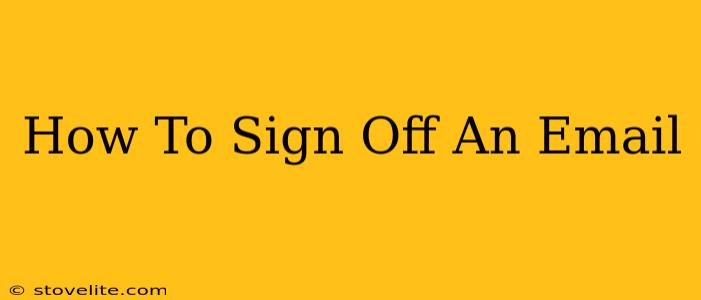Choosing the right email sign-off might seem trivial, but it’s a crucial element of professional communication. A well-chosen closing can leave a lasting positive impression, reinforcing your message and reflecting your professionalism. Conversely, a poorly chosen sign-off can undermine your efforts and leave a less-than-ideal impression. This guide will walk you through selecting the perfect email sign-off for various situations.
Understanding the Context: Choosing the Right Sign-Off
The best email sign-off depends heavily on your relationship with the recipient and the overall tone of your email. Consider these factors:
-
Your Relationship with the Recipient: Are you emailing a close colleague, a potential client, a superior, or a friend? The level of formality should adjust accordingly.
-
The Email's Purpose: Is it a casual update, a formal request, a complaint, or a thank-you note? Your sign-off should complement the email's purpose.
-
Your Company Culture: Some workplaces have preferred or mandated email sign-offs. Always check your company's style guide.
Formal Email Sign-Offs: Projecting Professionalism
For formal emails, maintain a professional and respectful tone. These sign-offs are ideal for clients, superiors, and business contacts you don't know well:
-
Sincerely: A classic and always appropriate choice. It's polite and conveys respect.
-
Respectfully: Suitable when showing deference or addressing someone of higher authority.
-
Regards: A common and versatile option for a professional yet slightly less formal tone than "Sincerely."
-
Cordially: A more friendly yet still professional option.
Informal Email Sign-Offs: Maintaining a Friendly Tone
When emailing colleagues, friends, or acquaintances you know well, a slightly less formal tone is acceptable. These options work well in less formal settings:
-
Best: Friendly and widely accepted.
-
Thanks: Suitable when you are expressing gratitude.
-
Cheers: Common in informal settings but avoid in highly professional contexts.
-
All the best: A warm and well-wishing sign-off.
Situational Sign-Offs: Tailoring to Specific Needs
Sometimes, a standard sign-off just won't cut it. Here are some situational options:
-
Thank You Emails: "Thank you," "Thank you so much," or "With sincere thanks" are appropriate.
-
Follow-up Emails: "Following up," "Checking in," or "Just a quick follow-up" clearly state your intention.
-
Emails Requesting Information: "Thank you for your time and consideration," or "I appreciate your assistance" are polite ways to conclude.
What NOT to Use in Your Email Sign-Off
Avoid these sign-offs to maintain professionalism and avoid appearing unprofessional:
-
Love: Unless you are emailing a close friend or family member, this is inappropriate for professional communication.
-
XOXO: Similar to "Love," this is highly informal and unsuitable for professional correspondence.
-
TTYL (Talk to you later): This is overly casual and should be avoided in professional contexts.
Crafting Your Email Signature
Your email signature should be concise, professional, and include essential information. This might include:
- Your full name
- Your job title
- Your company
- Your contact information (phone number, website)
Conclusion: The Power of a Perfect Sign-Off
The art of crafting the perfect email sign-off is about finding the right balance between formality and friendliness. By carefully considering your audience and the context of your email, you can ensure your sign-off enhances your overall message and leaves a positive and professional impression. Remember that attention to detail matters; a well-crafted email sign-off contributes significantly to effective communication.

